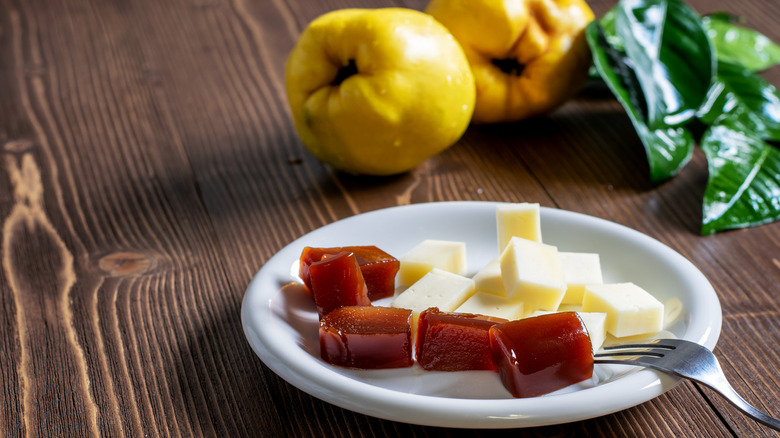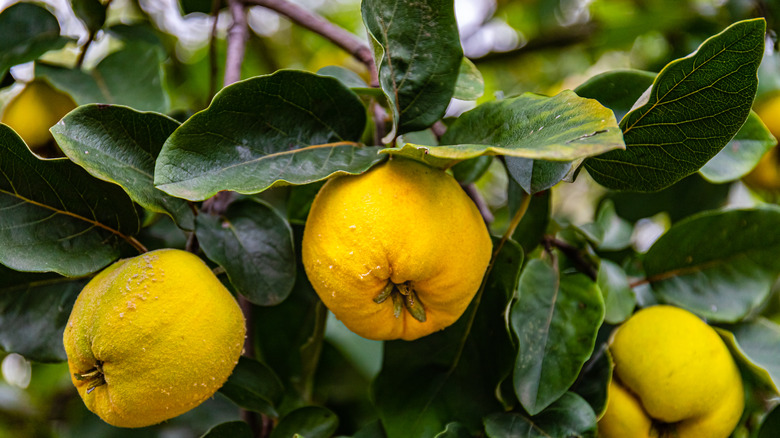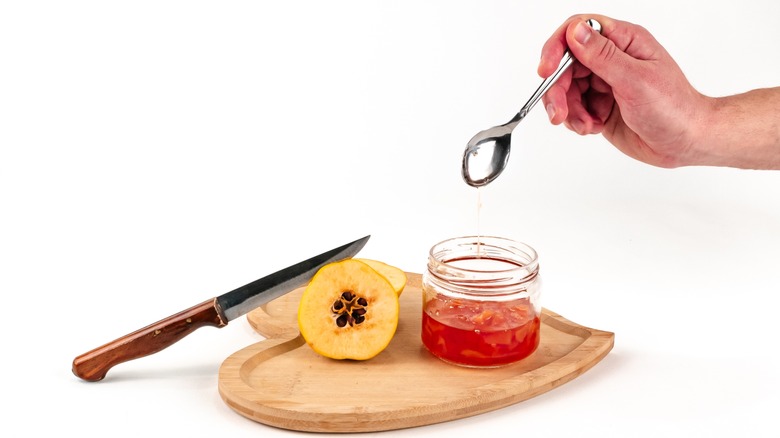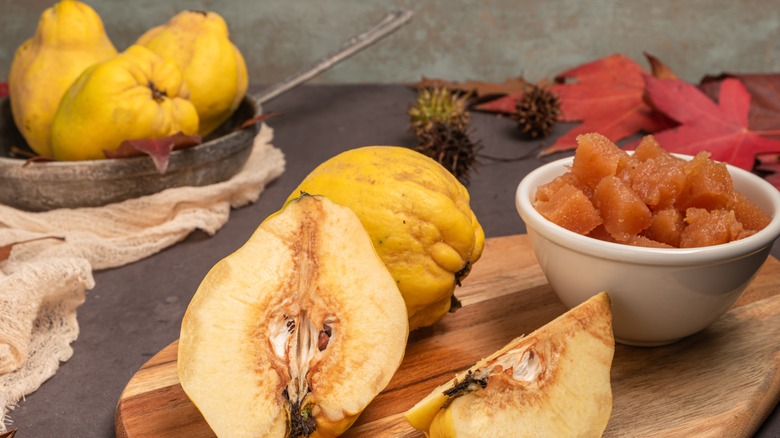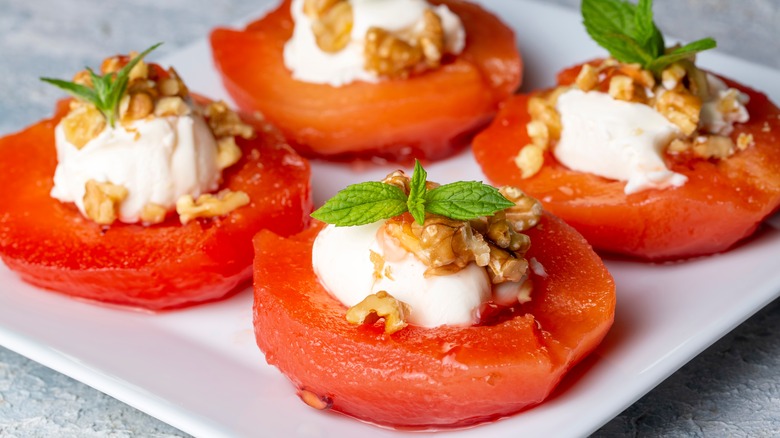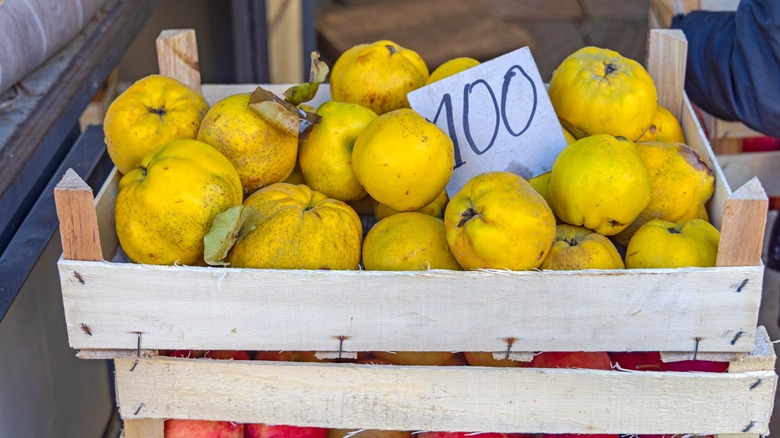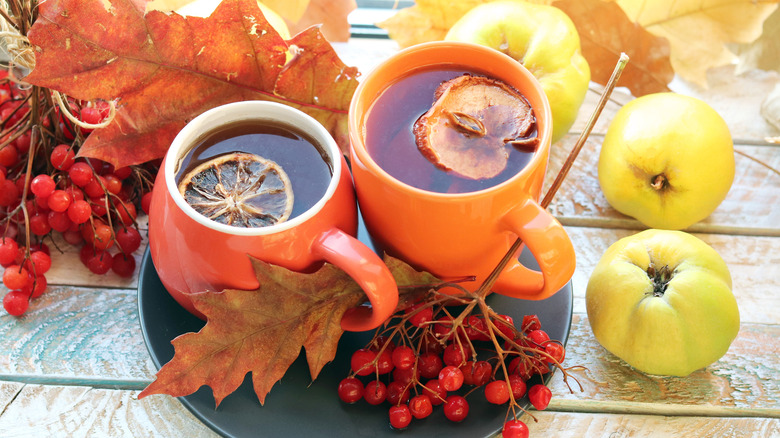A Beginner's Guide To Quince
The golden apples of Greek mythology were likely quince, not apples at all. This fruit was a symbol of Aphrodite and love. One ancient governor of Athens officially declared quinces a wedding fruit. Brides would eat one on their wedding night, likely to sweeten their breath before getting to know their husbands better.
The Greeks may have held quince in high regard, but today this fruit is hard to come by in supermarkets in the United States. Many people have never seen one, much less smelled, tasted or cooked with it. It's a shame, because the taste of these golden orbs is alluring — and unforgettable. Once you've tried a quince the right way, there's no going back.
Of course, that unforgettable taste explains why the quince has its fan club. Some people call it the definitive slow food — that's a compliment. Others, despite its obscurity, have set up quince farms and sell the fruit at farmers' markets. At least one organization has even gone to the trouble to set up a gene bank for quinces, collecting specimens from around the world and propagating them.
Knowing this probably makes you feel curious about the furry, yellow pear-shaped fruit. Read on if you want to know more about how they taste, where to find them, and what kinds of recipes to use quince in.
What are quinces?
The aroma of quinces is the first thing you notice. A wafting mix of apple and rose fills the air around this fruit when it's ripe. A bowl of quinces, sitting on a counter, can fill an entire home with the delicious scent. It's not surprising this fruit smells so good — it belongs to the same family as rose bushes. As delicious as the scent is, though, if you bite into one of these fruits, you'll probably spit it out immediately — uncooked, it tastes sour, bitter, astringent, and has a sandy texture.
You must cook quince because this is where more of the magic happens. This fruit doesn't look like much from the outside. Some would describe it as an oversized furry yellow lumpy thing — and when you chop it, the fruit chunks get even less attractive. The flesh immediately turns a rusty umber when the air touches it. Once the chunks are simmering in water, though, the color shifts once again. First, it becomes rosy-pink and then orangish. If you boil it long enough to make thick jam, the resulting puree turns a sparkling ruby red.
Varieties of quinces
The United States is home to one of the most diverse collections of quince DNA, despite many people in the U.S. have never eaten a quince. The National Clonal Germplasm Repository in Corvallis, Oregon has managed to identify and preserve 41 varieties from around the world.
There is the huge, football-shaped Portuguese specimen — one fruit can measure 7 inches long. On the other end of the spectrum, Aromatnaya from Russia, are small, sweet, and soft enough to eat raw. Large knobby Smyrna quinces originated in Greece — they're famously hard to chop. Californians created Pineapple quinces which have a flavor and scent reminiscent of their namesake. It's one of the most popular kinds for making jam. The Isfahan variety comes from Iran and while quinces always smell fantastic, this kind is famous for being particularly aromatic. Two of the most popular varieties from France are called Angers and De Bourgeaut — both make fantastic, deep red jam.
What do quinces taste like?
Quinces' scent hints at sweet flesh just under the yellow skin, but alas it is not so. These fruits are sour, more so than the sourest green apple you've ever tried. Douse that green apple in lemon juice and you might get close to the flavor of unsweetened quince. Then, the extra load of tannins in this fruit when it's fresh cause a dry sensation in the mouth. Add some sugar and boil a quince for a bit and the flavor transforms completely. It's still a bit sour, but in a nice way and now you'll detect a hint of vanilla and rose with the sweetness mitigating the acidic taste.
The flesh of this fruit is hard when raw, but cooked, it gets spongey and soft — easy to cut and eat with a spoon. Cut into cubes, the pieces puff up a bit in simmering water, only to contract back into well-defined cubes when the concoction cools. Even if you overcook them, quince pieces keep their shape and won't turn to mush unless you blend them or smash them with a fork.
Where are quinces popular?
Rob and Paula Siegel lived in Santiago, Chile for years. There, they learned to love the thick quince jam that locals eat with bread for breakfast. When they returned to the United States, the couple missed the product so much that they started a quince farm. They've had great success selling their produce online and some of their most avid buyers are immigrants from around the world who miss the fruit.
In Spain, Portugal, and Latin America people regularly eat thick quince spread with cheese. The Turkish prefer poaching the fruit with cinnamon and serving it for dessert. One Hungarian man commented on WebMD that his grandmother used to prepare quinces with cabbage and beef paprika. In Korea, people boil their quince to make tea. Stewed quince is popular in Lebanon and Iran. That being said, globally, the two largest producers and consumers of the fruit are China and Turkey.
At the same time, it's amazing that a fruit, so beloved around the world, remains relatively obscure in the U.S. It may have something to do with the time and care it takes to cook a quince into something delicious. It's far easier and quicker to grab an apple, wash it, and bite in — but if that's all you do, you're missing out on a truly distinct flavor.
What can you do with quinces?
The word "marmalade" comes from Portuguese "marmelo" meaning quince. This indicates a basic way to use quince: in jam. The fruit has a place in many other recipes as well, though. Boil quince cubes in syrup to get a delicious compote. Simmer only the skins and cores and then add sugar for a tempting pink jelly. Then, there's quince spread, paste, or cheese. This dish is firm enough that you can slice it as though it were cheese, but it's jam that's been cooked long enough to hold its shape. Other fruit jams never get this hard no matter how long they're on the stove, but the crazy amount of pectin in quinces makes it possible. Turn quince into fruit leather by pureeing it, adding sugar, and drying in the oven or a dehydrator.
In Turkey, it's popular to poach whole quince halves to make . Some recipes say to add hibiscus or cherries to the syrup to turn the fruit even more ruby colored. After around 90 minutes on the stove, cooks serve the bright red quince halves filled with pistachios and cream. They drizzle the remaining syrup over the top. Meanwhile, in Korea, mogwa-cha is the name for traditional quince tea.
You can also use quince in savory dishes. Try cutting them into slices, setting them on a baking tray with other veggies and roasting a chicken over them. Or, you can slowly stew meat, like lamb shanks, with quince quarters for amazing flavor.
What ingredients go well with quinces?
In an ancient Roman cookbook, "De re coquinaria" by Apicius, there's a recipe for preserving quince. The instructions say to put whole quinces in large clay vessels and pour a mixture of reduced new wine and honey over the fruit. Likewise, other recipes in the book also pair the fruit with honey. Romans probably liked this combination because the fruit was too sour otherwise.
Today, refined sugar is more readily available than honey and so that is most often added to quince. Modern Turkish and Middle Eastern recipes suggest adding an array of aromatic spices. These could include cardamon, cinnamon, and cloves to bring out the quince's taste. In Turkey, they add hibiscus for extra red color. In sweet pastries like pies and crumbles, people often combine this fruit with apples and pears. If you want to pair it with meat, a sauce of apple and quince brings out the best in pork.
Where can you buy quinces?
Finding quinces takes a little more work than heading to the produce aisle in your local grocery store, although you might see them once in a while in the fall. More likely, ask your local apple or pear grower — or head to the farmers' market, especially if you live in New England.
If you can't find a quince grower near you, order quinces online. Walmart's virtual shop offers quinces, but the price tag is astronomical. A little more than $50 will buy you six of the fruit. Oregon-based Quince Essential also ships quinces across the United States, but only in the fall while their stock lasts and that's not long — roughly 47 quince trees on a single acre produce a lot, but there's a limit. Quince Essential offers quince spread year round.
If you already know and love quinces, you might consider purchasing a tree from a nursery. For between $50 and $70, you'll get a bush that will provide you quinces to your heart's desire for years. Best of all, these trees are famously low-maintenance, needing little pruning or water, but providing a fantastic crop.
Mistakes to avoid with quinces
Whatever you do, don't bite straight into a raw quince and expect it will taste like it smells. There are people who enjoy the taste of this fruit uncooked, but they are few and far between. The texture will make your mouth feel dry, the sour taste will pucker your mouth, and you'll probably never want to eat another quince in you life.
It's also vitally important to choose ripe quinces for your recipes. If you've never bought one before, picking mature specimens can be a challenge. Most varieties of this fruit will turn lemon yellow when they're ripe and give off a strong perfume. Additionally, the fuzz on the skin should rub off easily. Once fruit is ripe, this hairy layer will have mostly fallen off on its own.
Finally, it's tempting to cut down on sugar in recipes. That's a huge mistake. This fruit is so sour that the sweetener is the only way to make them palatable. If you're worried about health implications of too much sugar, try using honey like ancient Romans did, or evaporated cane sugar for a less processed ingredient.
Are quinces healthy?
Quinces are jam-packed with nutrients. According to the USDA, quinces contain a significant amount of vitamins A, C, and potassium. The amount of vitamin C is amazing — you can get nearly 25% of your daily requirement from a single quince. According to the Canadian Academy of Sports Nutrition, the fruit also provides iron, copper, and a lot of fiber in the form of pectin which is good for preventing both diarrhea and constipation.
While there's not much scientific evidence to back up most of these claims, people around the world have long used quince as a home remedy for various ailments like heartburn, nausea, hay fever, and ulcers. A 2017 clinical trial published in the Journal of Obstetrics & Gynecology demonstrated this fruit's effectiveness in treating morning sickness. The researchers found that eating quince was more effective at subduing nausea in pregnancy than taking supplements containing vitamin B6. So anyone who's pregnant will probably want to add this to their diet.
